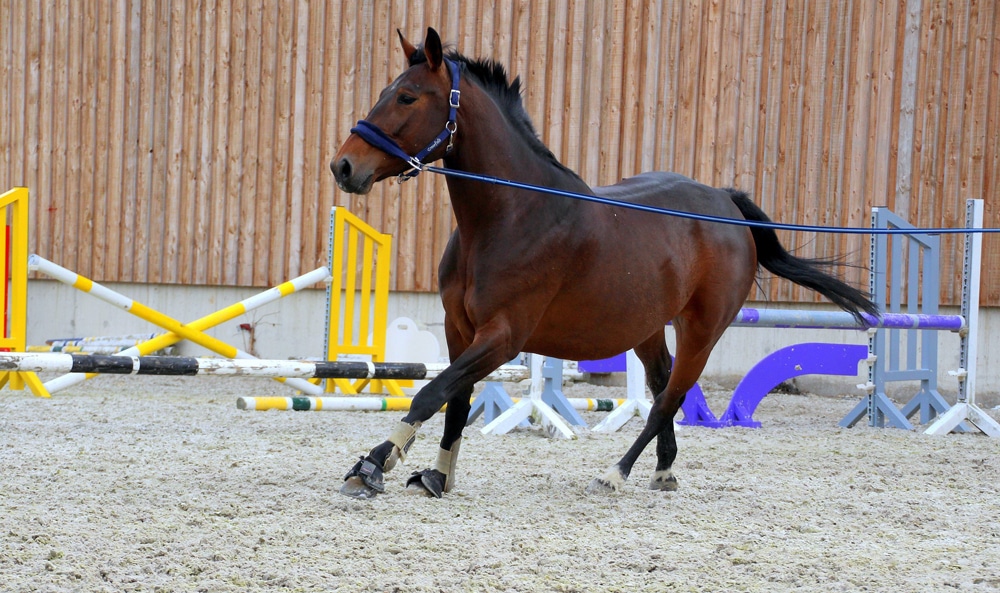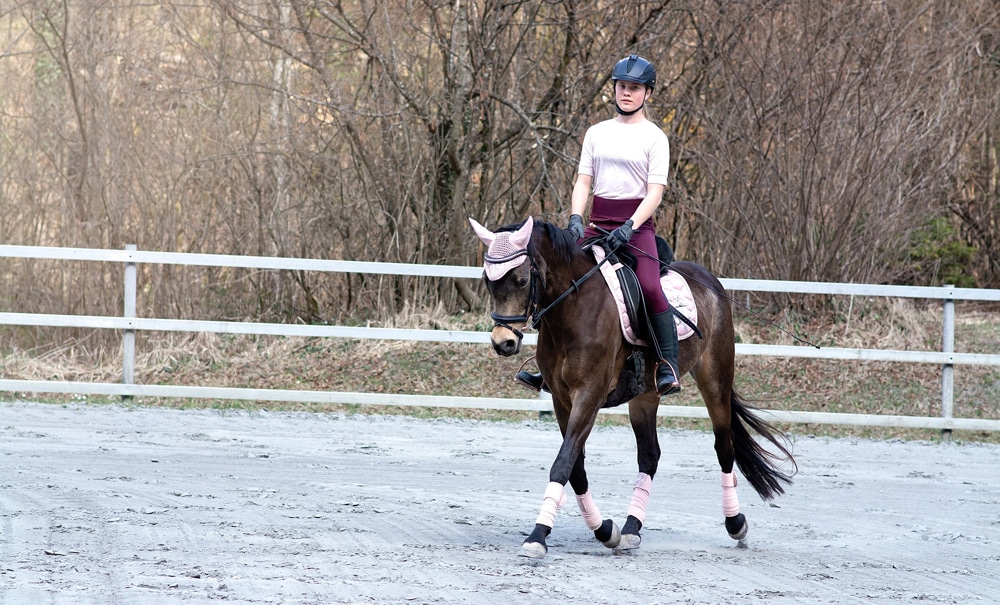Everyone needs to be able to ride straight – straight to a jump or straight on centreline.
But why is it better to be straight? Many horses/riders are just fine a little crooked (or a lot crooked) and still get over the jump or through a dressage test.
It comes down to balance, loading of the hind legs equally, and reducing or eliminating compensation that happens when a horse’s body has to hold itself up on one leg more than the others.
Being balanced and straight on all four legs makes it easier for the horse to be economical with their body, use their muscles and joints properly and not overload any one body part. Imagine you have someone holding you up or pushing you over while you walked down the street, or you have a blister on your ankle or a rock in your shoe so you walk a little differently to compensate. Eventually one leg, and maybe even your back or shoulder, becomes tired from being crooked. Over time, this builds up and creates inequality in muscle strength and development which can in turn result in injuries to the horse. It can also affect the rider who has to constantly support the horse; elbows, shoulders, hips and backs can be affected and in extreme cases, crooked horses can make even twist the tree of your saddle!
Horses are born a little curved one way or the other. You can see this when you lunge a horse in a halter ‒ one way they look normal and the other way they look to the outside. A young horse being straight may still look wide behind. Later, as the horse gets stronger and learns to carry more weight on the hind legs, the hind legs will come closer together and match the front legs.

Crookedness can be evident when lungeing if the horse bends properly going one direction and counterbends the other in just a halter. (Myriams-Fotos/Pixabay)
So if you think about straightness within the training scale, not only does straightness mean alignment, but also the ability for the horse to have both hind legs under the body at the same time so that it can carry more weight behind and develop more collection.
In order to have a straight horse, the rider is a major part of the equation. Many riders are not perfectly straight, nor are we ambidextrous (able to use both hands with an equal amount of coordination and dexterity) but we do ask our horses to be straight and as ambidextrous as possible. In order to help your horse to be straighter, the rider must also be aware of their body alignment both on and off the horse.
Of course, changing crookedness in both horse and rider takes time. But the time spent in working on making both straight is worth it in the longevity of the horse. So, where to do we start?
The Horse
- Is your saddle part of the problem, or professionally fitted to give you the best advantage possible?
- Is your horse in good physical condition (fitness level, soundness, flexibility, no muscle discomfort) to do the work required to help develop both sides of its body equally?
- Are his feet in good shape, properly trimmed (or shod) and balanced?
The Rider
- Check the wear on your own shoes ‒ is it the same on each? Are your boots broken in the same?
- Can you do some simple daily tasks with either hand?
- When you are on foot, how is your alignment and straightness? Are your hips and shoulders level while walking?
- Check your alignment in the saddle. Have someone take a picture or video of you from behind in the halt (with the horse as square as possible) and at the walk, trot and canter both leads and see if you sit in the middle of the saddle. Are your feet, hips, shoulders and elbows level? Also check if your saddle stays in the middle or if you pull it to one side.
- While riding, take notice if both reins hold the same amount of contact in all gaits going both ways, or if one has more than the other. Is it always the same side (likely) and is it you holding more on that side, or is it your horse?
- Check your seat bones. Are they equal in the saddle in all gaits?
- Check your leg pressure. Is your leg equally connected to the horse from seat bone, thigh, down through your calf, and is it the same on both left and right?
The Fix
All of that is now in place, but your horse still drifts. Ugh!
So is your drift to the left or to the right? Most likely it is the same in all gaits and the same as the natural curve in the horse. If your horse is curved to the left (looks normal going left on the lunge line) then drifts to the right, you will likely have more contact on the right side and use more right leg more of the time.
The leg yield and turn on the forehand are effective corrections for the drift. Use the turn on the forehand, making sure the neck is very straight, with the horse’s head centred over in the middle of their chest as they step sideways. One direction will be easier than the other. Your goal is to make both ways as equal as possible. This will help close the space for the drift and help create a border for the horse to not drift into when back on the straight line.

Practice riding straight lines frequently off the rail, not always relying on it to keep your horse aligned. (Petra/Pixabay)
Be mindful not to just pull with steady constant contact. The contact should be elastic and soften to allow the horse to step under. Your goal is to have light, easy leg aids so that when you walk away from your turn on the forehand exercise your horse stays straight in the middle of both legs and you are not required to “keep” him straight.
Once you have a turn on the forehand and leg yields as close to equal both ways, recheck your straightness on a free line (centreline, quarter line or towards a jump). Use your eyes on an end point to keep your destination clear. Does your horse stay on that line without a lot of help from you?
Don’t be shy to use other little corrections like shoulder-fore, shoulder-in or a little travers positioning if you need more finesse on your line. However, don’t forget your end goal is to be able to have your horse go straight and stay on the line you choose without too much help from you!
And finally, use mirrors or have someone video you to check your progress. Use visual points to ride to such as markers on the wall or cones; use the coloured stripes of the jump rails to focus on the middle of the line and stay on it.

